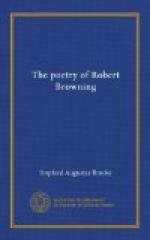That is enough to prove his power. And the animals are seen, not as a cultured person sees them, but as a savage, with his eyes untroubled by thoughts, sees them; for Browning, with his curious self-transmuting power, has put himself into the skin of Caliban. Then again, in that lovely lyric in Paracelsus,
Thus the Mayne glideth,
the banks and waves are full of all the bird and beast life of a river. Elsewhere, he sees the falcon spread his wings like a banner, the stork clapping his bill in the marsh, the coot dipping his blue breast in the water, the swallow flying to Venice—“that stout sea-farer”—the lark shivering for joy, and a hundred other birds; and lastly, even the great bird of the Imagination, the Phoenix, flying home; and in a splendid verse records the sight:
As the King-bird with ages
on his plumes
Travels to die in his ancestral
glooms.
Not less wonderful, and more unique in English poetry, is his painting of insects. He describes the hermit-bee, the soft, small, unfrighted thing, lighting on the dead vine-leaf, and twirling and filing all day. He strikes out the grasshopper at a touch—
Chirrups the contumacious grasshopper.
He has a swift vision of the azure damsel-fly flittering in the wood:
Child of the simmering quiet, there to die.
He sees all the insect population of an old green wall; fancies the fancies of the crickets and the flies, and the carousing of the cicala in the trees, and the bee swinging in the chalice of the campanula, and the wasps pricking the papers round the peaches, and the gnats and early moths craving their food from God when dawn awakes them, and the fireflies crawling like lamps through the moss, and the spider, sprinkled with mottles on an ash-grey back, and building his web on the edge of tombs. These are but a few things out of this treasure-house of animal observation and love. It is a love which animates and populates with life his landscapes.
Many of the points I have attempted here to make are illustrated in Saul. In verse v. the sheep are pictured, with all a shepherd’s delightful affection, coming back at evening to the folding; and, with David’s poetic imagination, compared to the stars following one another into the meadows of night—
And now one after one seeks
his lodging, as star follows star
Into eve and the blue far
above us,—so blue and so far!—
In verse vi. the quails, and the crickets, and the jerboa at the door of his sand house, are thrilled into quicker life by David’s music. In verse ix. the full joy of living in beasts and men is painted in the midst of landscape after landscape, struck out in single lines,—till all nature seems crowded and simmering with the intense life whose rapture Browning loved so well. These fully reveal his poetic communion with animals. Then, there is a fine passage in verse x. where he describes the




